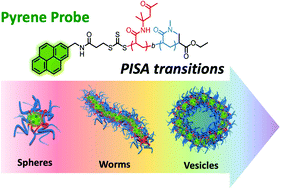In situ monitoring of PISA morphologies†
Abstract
Polymerization-induced self-assembly (PISA) is a facile method to obtain block copolymer aggregates with defined morphologies. However, the transitions between these morphologies have been difficult to monitor directly in real-time during the polymerization. Herein, we describe a straightforward and readily accessible in situ method to monitor the evolution of nanostructure via changes in internal hydrophobicity during the PISA process using a polymer-tethered pyrene fluorescent probe. We were able to correlate morphological transitions with changes of the pyrene emission and gain unprecedented insight into the evolution of core hydrophobicity during PISA.

- This article is part of the themed collection: Polymerization-Induced Self-Assembly (PISA)


 Please wait while we load your content...
Please wait while we load your content...